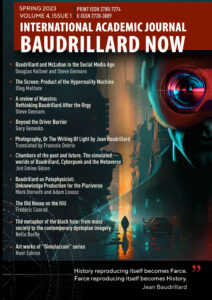
Neo-modernism versus postmodernism in reshaping the “spirit of science”…
By Lucien-Samir Oulahbib (CLESID, Lyon 3, France, director of dogma.lu review and two collections in Harmattan French publisher (commentaries Philosophy and epistemology and philosophy of sciences)).
I believe Oleg may not totally agree with what I have to say (but maybe later?…) but the path opened by Baudrillard and followed precisely by Oleg Maltsev author of this remarkable work (a habilitation; following its french meaning post-doctoral qualification) must be seen as a very new tentative to articulate art and science in the spirit of Goethe (in the Affinity electives) and, further, Leibnitz, Platoon (Plato) or Aristoteles (Aristotle) to consider for instance that the “old fashion way” (the so famous “Old School”). To think about their invisible but solid and vivid links, is well more superior (as Leo Strauss already said regarding Maimonides in Philosophy and Law) than the so called “modernity rationality”; because the first one, as Baudrillard, and Maltsev magestrally reopen it, is, in some way, a sort of symbolic fluid, like Ariadne’s thread found only by The Dexterous Butcher of Chuang Tzu (as Baudrillard often spoke about) i.e., how to catch the mysterious Link (bond) between the imaginary, the metaphysical, human flesh, the soul and political nature without falling for the Simulation, which kills all Reality, or the Perfect Crime: one of Baudrillard’s book titles which indicated the purpose in this last theoretical work: to go behind reality, just as was attempted by Rimbaud when he went to Africa with a photograph machine, Baudrillard had his own too…In our so call “modernity” this kind of so mysterious but very vivid link (which knews Evil but fight against it as a Divinity Challenge) is reducing under our eyes just as would a show: the imaginary and symbolic became in that way shrunken, as happens in the Honoré de Balzac novel The Skin of Sorrows, down to their language of logic; but it’s not enough to understand the very sense of their universel each either, which touches simultaneity human flesh and the “Soul of the World” as Schelling wrote. Hegel, in his earlier studies during his Iéna period, has recognized (in Logic and Metaphysics, the Jena System) that if you want indeed to understand the links between the visible and invisible (as Maurice Merleau-Ponty also said in this very last work) you have to go deeper among it and embrace all of its system and not just objectify them through separation; in fact, as Maltsev shows in this very in depth and new research, a lot of levels or fields or data that frame your perception must be considered together (Husserl also said this, but not in the Berkeleyian way, but rather in a way closer to Quine because there Reality prevails). In this sense, where it’s necessary to hold all of the fields as a mosaic which is reflected in your brain; Raymond Boudon and Jean Baechler (French students of Raymond Aron) know this about the levels of reality, but without esthetic reflections as added support as Maltsev has made; perhaps because art is dead in the EU, as we saw in the theater of occidental painting and so on, and as Baudrillard has already demonstrated when he wrote his famous Traverse Beaubourg museum review.
So, as Oleg Maltsev has designed and demonstrated this (in his novel and achievement of academic work.) we need to find a dynamic frame with all of those levels of reality taken together, and not consider each field just field by field, speciality by speciality, in too narrow ways; precisely because we want keep true contact with the world and not just believe that we knew something even in the Socraterian way. Why do we have an empty world (not just some “empty words”) and not something? Baudrillard asked this question as he analyzed and the matrix of the simulacrum; when the “real” territory disappears in favor on the (Google) map with a global sect behind who built the spectacle of simulation in order to hide his its simulacrum (the machine which devours the Real but left the front as can be seen regarding Potemkin Village) and, as Orwell taught us, to force you to believe that 2+2= 5 in all fields (Derrida, Foucault and Deleuze didn’t catch this); it’s why the simulacrum is not just the spectacle of the simulation as Debord said, but its the total disappearance as Isaac Asimov also mentioned, remarkably, in his Fondation series. It’s why I suppose that Oleg Maltsev is in his own Prelude…To capture the actual movement of our universe of…
Discover more from BAUDRILLARD NOW
Subscribe to get the latest posts sent to your email.


